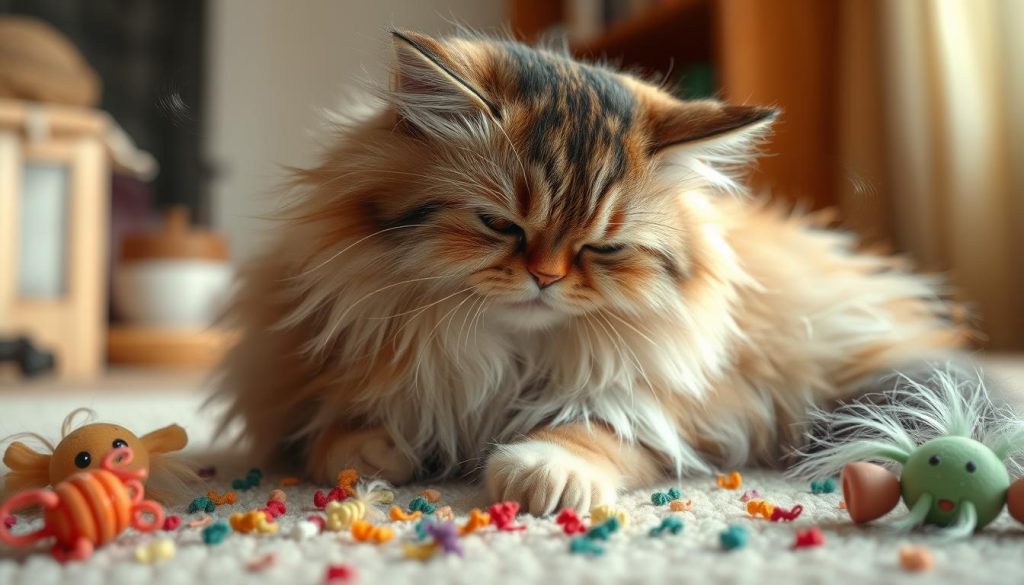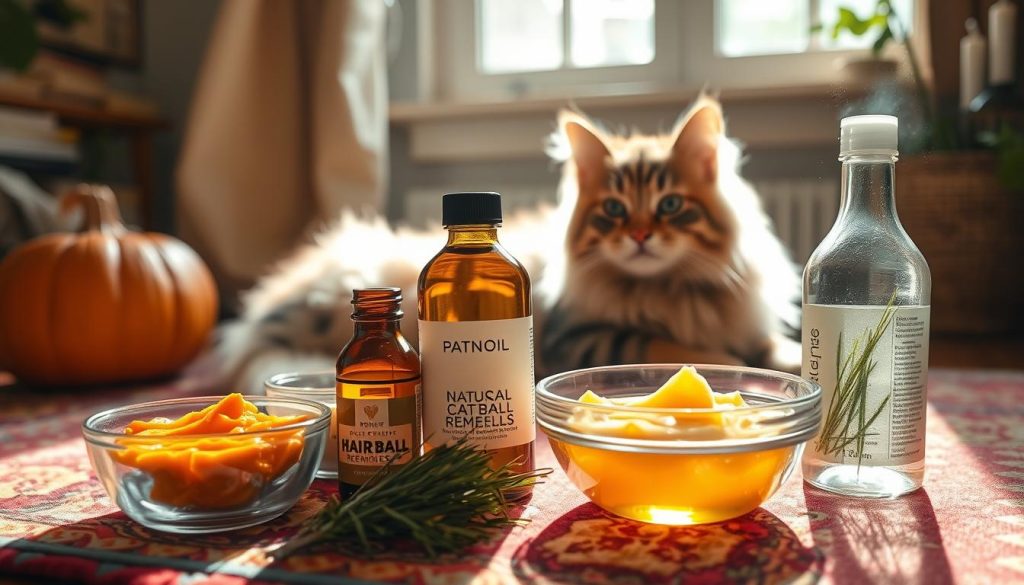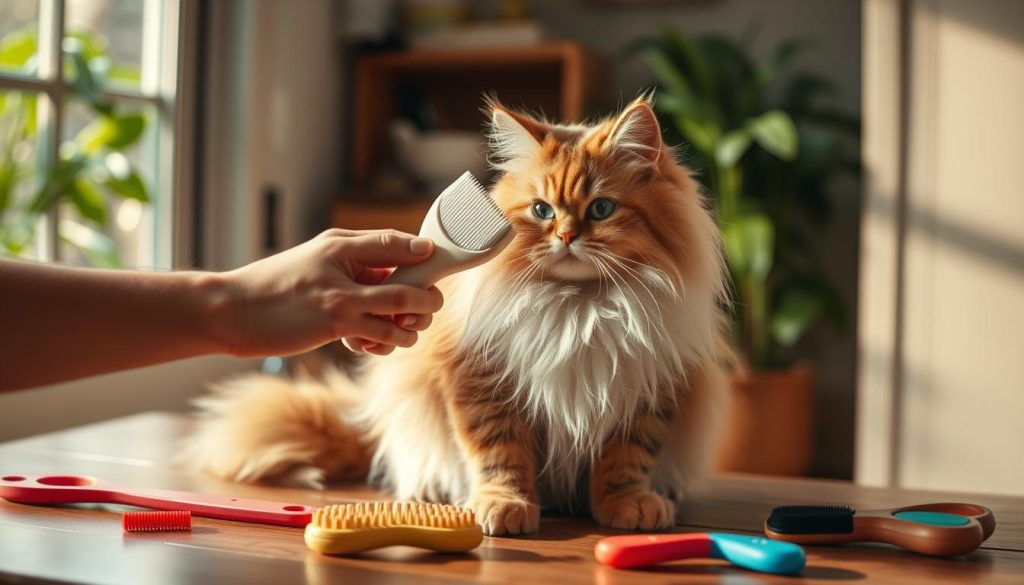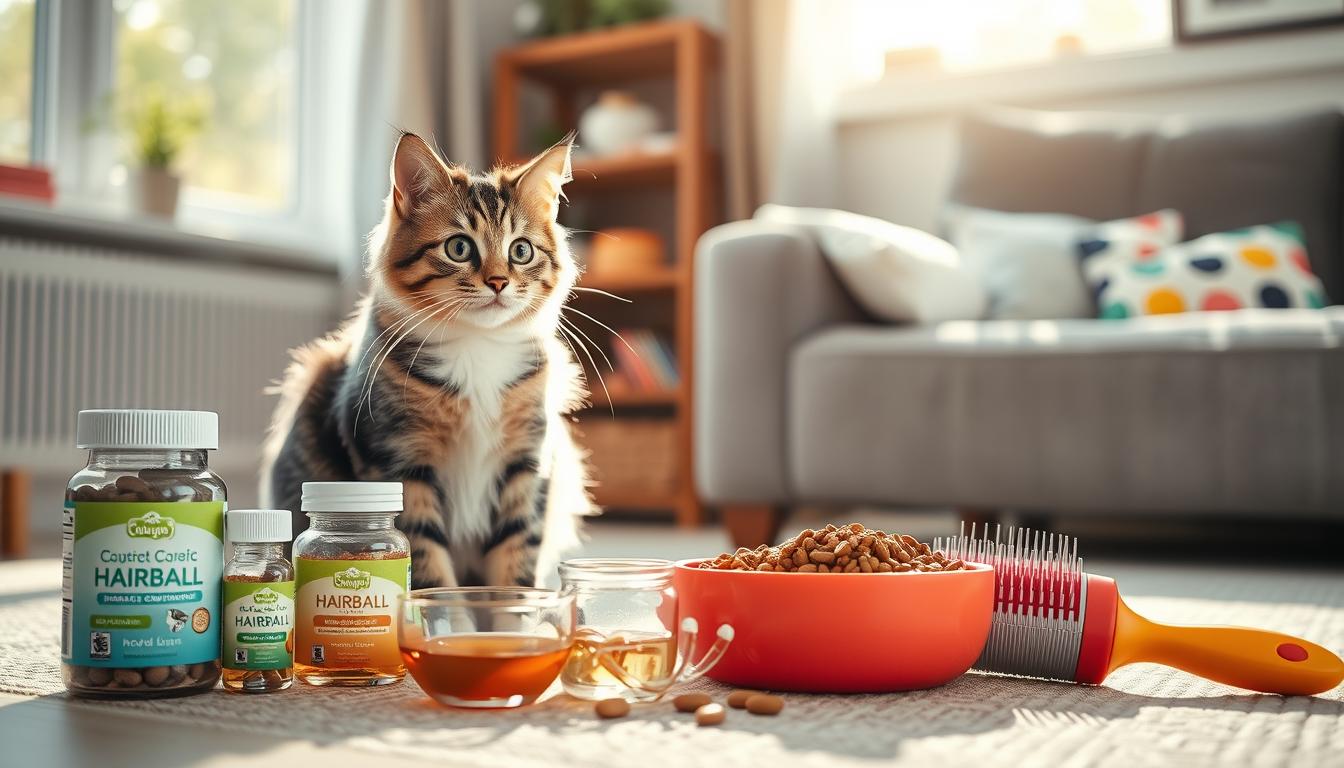As a devoted cat owner, I know how tough hairballs can be. They can make your cat and your home look messy. But don’t worry, I’m here to help. I’ll show you how to keep your cat happy and healthy with the right hairball remedies.
In this article, we’ll look at why hairballs happen and how to spot them. We’ll also explore natural and effective ways to solve this problem. Whether your cat often gets hairballs or you want to prevent them, you’ll find useful tips here.
We’ll talk about the importance of grooming and how to change your cat’s diet. So, let’s start and find out how to stop hairballs. This way, your cat can stay comfortable and happy.
Understanding Cat Hairballs: A Common Feline Woe
Hairballs are a big problem for many cats, causing them discomfort. It’s important to know why they happen and how to spot them in your cat.
What Causes Hairballs in Cats?
Cats groom a lot, which leads to fur getting stuck in their stomachs. This fur forms hairballs. Things like stress, boredom, or skin problems can make this worse.
- Excessive grooming due to stress, boredom, or skin irritation
- Dietary issues, such as a lack of fiber or poor-quality food
- Certain medical conditions, like thyroid disorders or gastrointestinal problems
Signs Your Cat Might Be Struggling with Hairballs
Knowing the signs of hairballs in cats can help you act fast. Look out for these signs:
- Frequent vomiting, especially after grooming sessions
- Retching or gagging, which may precede the expulsion of a hairball
- Decreased appetite or lack of interest in food
- Constipation or difficulty passing stool
- Excessive licking or grooming, which can exacerbate the problem
By understanding hairballs and their signs, you can help your cat feel better. This makes them more comfortable and healthy.

Cat Hairball Remedies: Natural and Effective Solutions
Dealing with cat hairballs doesn’t have to be hard. I’ll share natural and effective ways to help your cat feel better. You’ll learn about natural hairball remedies for cats and over-the-counter cat hairball treatments.
Hairball-control formulas are a popular home remedy for cat hairballs. These products, like pastes or gels, have ingredients that help move hairballs out. Just put a little on your cat’s paw or mix it with their food to see a difference.
Adding fiber-rich foods to your cat’s diet is another natural way. Canned pumpkin is a tasty option that can help move hairballs. You can also try over-the-counter cat hairball treatments with fiber supplements to prevent hairballs.
| Natural Hairball Remedies for Cats | Benefits |
|---|---|
| Hairball-control formulas (pastes or gels) | Lubricate the digestive tract to facilitate hairball expulsion |
| Fiber-rich foods (canned pumpkin) | Help move hairballs through the digestive system |
| Fiber supplements | Reduce the formation of hairballs |
While these natural hairball remedies for cats work well, always talk to your vet first. They can help find the best solution for your cat. With the right care, you can manage your cat’s hairballs and keep them healthy.

Grooming Your Cat: A Proactive Approach to Hairball Prevention
Regular grooming is key to managing hairballs in cats. By adding a grooming routine to your cat’s care, you can cut down on hairballs. We’ll look at grooming’s benefits and the best brushing methods to stop hairballs.
Brushing Techniques to Reduce Hairballs
Proper brushing is a big help in stopping hairballs. For cat grooming for hairball prevention, brush your cat often, at least a few times a week. This removes extra hair before they swallow it while grooming. Use a soft-bristled brush or grooming glove to gently take off loose fur, focusing on areas that easily mat, like the belly and hind legs.
The Benefits of Regular Grooming
- Promotes healthy skin and coat by distributing natural oils
- Reduces the amount of loose hair that can be swallowed, leading to fewer hairballs
- Strengthens the bond between you and your feline friend
- Allows you to regularly inspect your cat’s skin for any abnormalities or potential issues
The importance of regular cat grooming is huge. By making grooming a regular part of your cat’s care, you can lower hairball risks and boost their health. Remember, proper brushing techniques for cats are crucial for your cat’s comfort and to keep them hairball-free.

Dietary Adjustments: Fueling Your Cat’s Hairball Defense
Your cat’s diet is key to fighting hairballs. By tweaking their diet, you can boost their digestive health. This helps reduce hairballs. I’ll show you how to improve your cat’s diet for better hairball control.
Adding fiber-rich foods is a smart move. Pumpkin, psyllium husk, and beet pulp help with bowel movements. They make hair pass through easily, solving hairball problems and boosting your cat’s health.
Also, look into cat foods made for hairball control. These foods have more fiber and omega-3 and omega-6 fatty acids. They support a healthy coat and digestive system. These options can really help keep your cat’s hairballs away.

